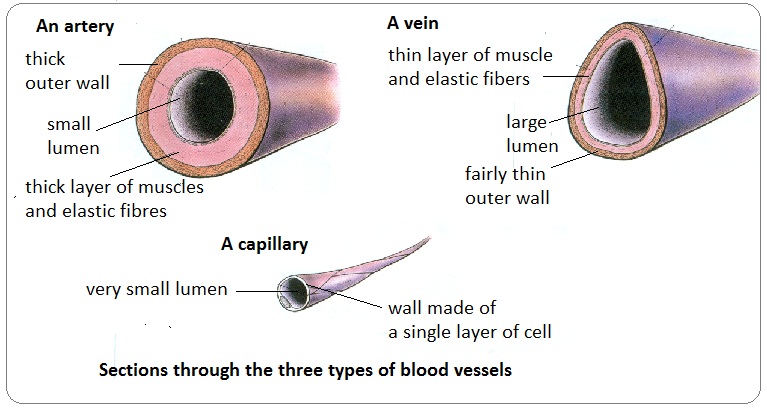BLOOD VESSELS

There are three main kinds of blood vessels: arteries, capillaries and veins [you can see in the figure above]. Arteries carry blood away from the heart. They divide again and again, and eventually from very tiny vessels called capillaries. The capillaries gradually join up with one another to form large vessels called veins. Veins carry blood towards the heart.
Arteries
When blood flows out of the heart, it enters the arteries. The blood is then at very high blood pressure, because it has been forced out of the heart by the contraction of the muscular ventricles. Arteries therefore need very strong walls to withstand the high pressure of the blood flowing through them.
The blood does not flow smoothly through the arteries. It pulses through, as the ventricles contract and relax. The arteries have elastic tissue in their walls which can stretch and recoil with the force of the blood. This helps to make the flow of the blood smoother. You can feel your arteries stretch and recoil when you feel your pulse in your wrist.
The blood pressure in the arteries of your arm can be measured using sphygmomanometer [you can see the picture above].
Capillaries
The arteries gradually divide to form smaller and smaller vessels [you can see the figure above]. These are the capillaries. The capillaries are very small and penetrate to every part of the body. No cell is very far away from a capillary.
The function of the capillaries is to take nutrients, oxygen and other materials to all the cells in the body, and to take away waste materials. To do this, their walls must be very thin so that substances can get in and out of them easily. The walls of the smallest capillaries are only one cell thick (you can see the first figure above).
Veins
The capillaries gradually join up again to form veins. By the time the blood gets to the veins, it is much lower pressure than it was in the arteries. The blood flows more slowly and smoothly now. There is no need for veins to have such thick, strong, elastic walls.
If the veins were narrow, this would slow down the blood even more. To help keep the blood moving easily through them, the space inside the veins, called lumen, is much wider than the lumen of the arteries.
Blood is also kept moving in the veins by the contraction of muscles around them (you can see the figure above). The large veins in your legs are squeezed by your leg muscles when you walk. This helps to push the blood back up to your heart. If a person is confined to bed for a long time, then there is a danger that the blood in these veins will not be kept moving. A clot may form in them, called thrombosis. If the clot is carried to the lungs, it could get stuck in the arterioles. This is called a pulmonary embolism, and it may prevent the circulation reaching part of the lungs. In serious cases, this can cause death.


